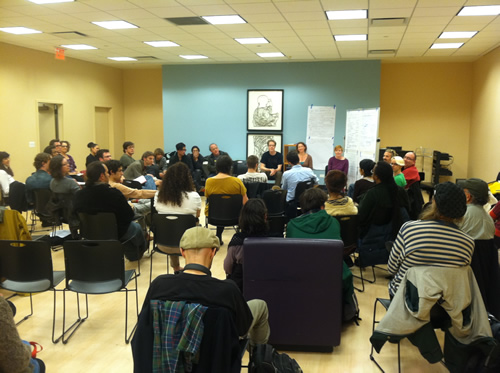Allegro
‘Twice the Work and Half the Pay’
Musicians put their heads together at a solidarity strategy summit
Volume 113, No. 1January, 2013

Artists and other creative workers gathered at Judson Memorial Church to discuss working conditions and strategies for solidarity. Seated at the front of the room are the facilitation team Matt Plummer, Sundrop Carter and Blithe Riley.
Artists unite! Earlier this fall, musicians and other workers gathered for a facilitated discussion at Judson Memorial Church, coordinated by the Musicians Solidarity Council, 99 Pickets and OWS Arts and Labor. The event, entitled “Twice the Work, Half the Pay: Entrepreneurship and Exploitation in the Music Industry,” was put together to discuss the challenges and successes of organizing workers who see themselves as freelancers, independent contractors or entrepreneurs. Most of the 40 or so participants were musicians, but a taxi driver, a fashion designer, figure skating coaches, dancers, visual artists, culture industry workers and writers also participated.
Many of the musicians articulated a general impression of stagnation and decline in the music industry in New York City in the last 30 years with complaints about:
-
working for tips, working for below minimum wage or working for free
-
wage theft
-
inconsistent gigs
-
multiple employers
-
a lack of respect for their profession
-
exploitation by agents, contractors, media and tech companies
-
digital and electronic media replacing live music
-
lack of employment opportunities
-
lack of resources
There were mixed reactions regarding the emphasis today on identifying as an “entrepreneur” and embracing entrepreneurship. On one hand, being an entrepreneur can be creative and fulfilling. On the other hand, as income and security for the musician and freelancer are being chipped away, the artist is forced to wear all hats in order to survive and becomes an entrepreneur only out of necessity.
To move the discussion in a more positive direction, two figure skating coaches were asked to talk about how they successfully organized independent workers in contract negotiations with a rink owner. They attributed their success to the formation of a smaller, core group of organizers and stressed the need to have the most qualified people in positions of power and influence. Although at times they had to play hardball, getting all the workers on board and petitioning management with specific demands, they also recognized it was in their best interest, at times, to pull back and negotiate in non-confrontational ways on other issues. Approaching management more one-on-one, in a more communicative and diplomatic way that recognized compromise, said the coaches, could also be helpful. It was their job, they said, to really be aware of what strategy to use and when. Because they had a track record of successful negotiations as well as long-term relationships with others, they were seen as leaders with everyone’s best interest at heart.
Musicians from Noise Action Coalition also spoke about the successful strategy of having an active, well-connected, small organizing committee. They emphasized building momentum and popular opinion around a specific grievance or against a specific venue and talked about the importance of their partnership with the union.
In discussing music collectives, MOBI (Musicians of Brooklyn Initiative) and Douglass Street Music Collective were cited as successful collectives largely due to being artist-run and having rotating leadership. There was some discussion about expanding the collective model to the promotion side and developing collectives with public relations and artist relations people, creating an artist-centered microcosm of the industry. The desire for an all-embracing collectivist structure was also voiced by a freelance fashion designer interested in creating an open source environment where people would work together in affinity groups and split income distribution equally.
Several musicians said they no longer play at clubs where they are expected to play for tips only. This led to talk of creating a Fair Music certificate that would be given to clubs that adhere to a set of standards. Musicians could choose to play only at the Fair Music clubs and the general public could show their support for the musicians by patronizing these clubs.
People spoke about the importance of building community and the need to be ethical and respectful toward each other. A sense of urgency to collectively address the deteriorating conditions for musicians and workers was also expressed. Local 802 member Keisha St. Joan spoke about the union’s Justice for Jazz Artists campaign. Bassist Melvin Gibbs spoke about organizing musicians to win a contract at the Winter Jazzfest, an effort that took place with union assistance.
In a spirit of solidarity and unity, the evening ended with an enthusiastic march to the Blue Note with Local 802’s Justice for Jazz Artists campaign.
To learn more about this event and to be notified for similar events in the future, see the Web site of the Musicians Solidarity Council at www.mussc.org.
Julie Harting’s tuba quartet “Catacombs of Light” premiered at the 2011 ISCM World New Music Days in Croatia. Her other works have been performed in various venues throughout New York. Harting earned her D.M.A in music composition from Columbia University. To contact her, e-mail JulieHarting@yahoo.com or visit www.JulieHarting.com.
